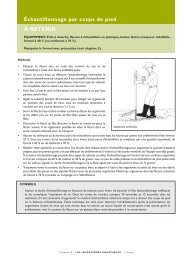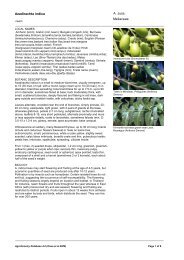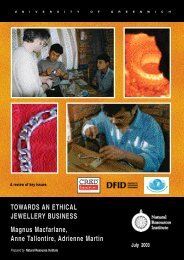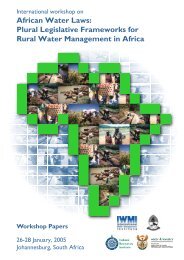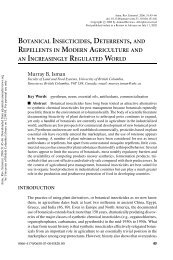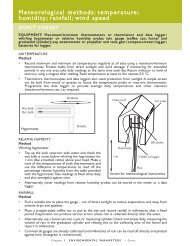Farmers' ethno-ecological knowledge of vegetable pests and ...
Farmers' ethno-ecological knowledge of vegetable pests and ...
Farmers' ethno-ecological knowledge of vegetable pests and ...
Create successful ePaper yourself
Turn your PDF publications into a flip-book with our unique Google optimized e-Paper software.
Figure 5. Perception <strong>of</strong> availability <strong>of</strong> pesticidal plants among Malawian <strong>and</strong> Zambian respondents.<br />
with reports from other parts <strong>of</strong> Zambia (Kuntashula et<br />
al., 2006) <strong>and</strong> Malawi (Mw<strong>and</strong>ira, 2003) showing that<br />
farmers grow <strong>vegetable</strong>s during both the wet season (in<br />
the up-l<strong>and</strong> fields) <strong>and</strong> dry season (in the wetl<strong>and</strong>s). With<br />
the availability <strong>of</strong> heat-tolerant cultivars, crucifers such as<br />
cabbage are now cultivated throughout the year in<br />
southern Africa (Kfir, 2003). This has implications on the<br />
build-up <strong>of</strong> pest populations. The results <strong>of</strong> this study also<br />
support earlier reports that tomatoes <strong>and</strong> crucifers are the<br />
main <strong>vegetable</strong>s grown widely in the two countries<br />
(Nkhungulu <strong>and</strong> Msikita, 1985; Obopile et al., 2008;<br />
Theu, 2008). This indicates how important these<br />
<strong>vegetable</strong>s are to the subsistence farmers in the study<br />
areas.<br />
According to the farmers’ perceptions, red spider mite<br />
<strong>and</strong> bollworms are the major insect <strong>pests</strong> <strong>of</strong> tomato, while<br />
the diamond back moth, webworms <strong>and</strong> aphids are major<br />
<strong>pests</strong> <strong>of</strong> crucifers in Northern Malawi <strong>and</strong> Eastern<br />
Zambia. This is consistent with the literature from other<br />
parts <strong>of</strong> Southern Africa (Grzywacz et al., 2010; Obopile<br />
et al., 2008; Sib<strong>and</strong>a et al., 2000). The red spider mite is<br />
an invasive species in Africa <strong>and</strong> the present findings<br />
highlight its increasing importance in the region. Wide<br />
expansion <strong>of</strong> the mite to new areas in Africa has been<br />
predicted (Migeon et al., 2009), thus new technologies to<br />
manage this pest that are particularly relevant for<br />
resource-poorest farmers need to be identified <strong>and</strong><br />
promoted. The diamond back moth <strong>and</strong> aphids (B.<br />
brassicae, Lipaphis erysimi <strong>and</strong> Myzus persicae) have<br />
been identified as the most damaging <strong>pests</strong> <strong>of</strong> crucifers in<br />
most <strong>of</strong> Eastern <strong>and</strong> Southern Africa (Grzywacz et al.,<br />
2010; Kfir, 2003; Sib<strong>and</strong>a et al., 2000) <strong>and</strong> the present<br />
survey confirms this to be the case for Malawi <strong>and</strong><br />
Zambia too. Other major <strong>pests</strong> <strong>of</strong> crucifers include<br />
caterpillars such as the cabbage webworm that seriously<br />
damage cabbage in Eastern Zambia (Kuntashula et al.,<br />
2006).<br />
Results <strong>of</strong> this study are also in agreement with reports<br />
<strong>of</strong> the growing dependence on synthetic insecticides for<br />
the control <strong>of</strong> <strong>vegetable</strong> crop <strong>pests</strong> (Grzywacz et al.,<br />
2010; Obopile et al., 2008; Orr <strong>and</strong> Ritchie, 2004). For<br />
example, Orr <strong>and</strong> Ritchie (2004) reported up to 19<br />
applications to tomato <strong>and</strong> 14 applications to cabbage<br />
per year in the wetl<strong>and</strong>s <strong>of</strong> Southern Malawi. Most <strong>of</strong> the<br />
pesticides applied are potent toxins <strong>and</strong> their intensive<br />
use poses potential hazards to humans, livestock <strong>and</strong> the<br />
environment (Chambers et al., 2001; Ngowi et al., 2007).<br />
The fact that farmers applied insecticides that were not<br />
recommended for <strong>vegetable</strong> pest control is indicative <strong>of</strong><br />
the poor <strong>knowledge</strong> associated with pesticide use <strong>and</strong><br />
the potential problems this can cause. Incorrect use can<br />
be ineffective <strong>and</strong> even exacerbate the problem by<br />
encouraging the emergence <strong>of</strong> resistant pest populations.<br />
For example, the diamond back moth has developed<br />
resistance to a wide range <strong>of</strong> common insecticides in<br />
Africa <strong>and</strong> Asia (Grzywacz et al., 2010). With the<br />
widespread use <strong>of</strong> insecticides in Southern Africa, local<br />
populations <strong>of</strong> this pest have started developing<br />
resistance to synthetic pyrethroids, organophosphates<br />
<strong>and</strong> carbamates (Kfir, 2003). The indiscriminate use <strong>of</strong><br />
chemical pesticides to achieve higher <strong>vegetable</strong> yields<br />
could lead to disruption <strong>of</strong> natural control systems,<br />
increase the risk <strong>of</strong> contamination <strong>of</strong> the farm<br />
environment, pesticide residues in fresh produce <strong>and</strong>



